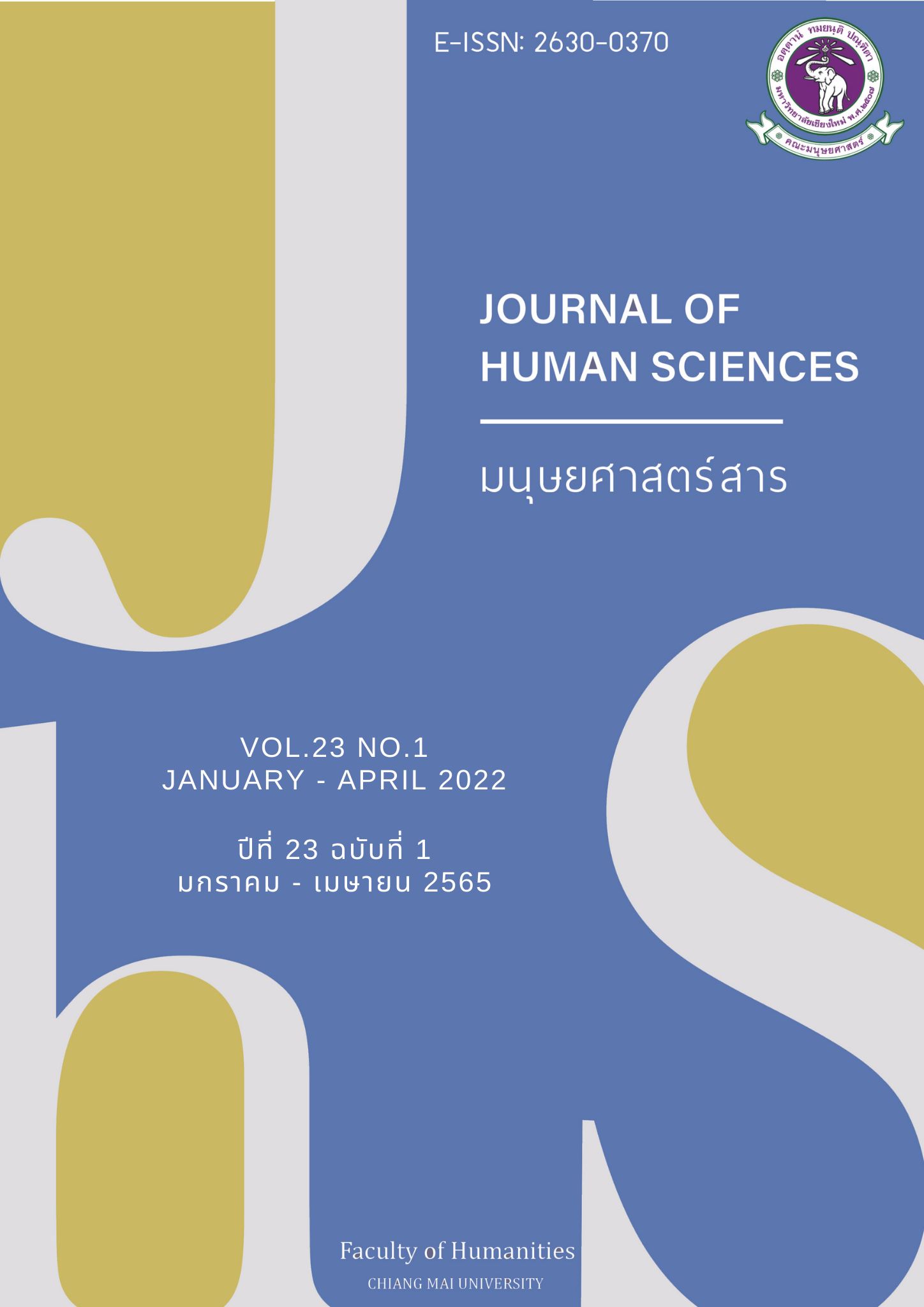การศึกษาภูมิทัศน์ทางภาษาศาสตร์ด้านภาษาจีน และกลวิธีการแปลชื่อธุรกิจร้านค้าในแหล่งท่องเที่ยวจังหวัดเชียงใหม่
Main Article Content
บทคัดย่อ
งานวิจัยเรื่องการศึกษาภูมิทัศน์ทางภาษาศาสตร์ด้านภาษาจีนและกลวิธีการแปลชื่อธุรกิจร้านค้าในแหล่งท่องเที่ยวจังหวัดเชียงใหม่ มีวัตถุประสงค์เพื่อศึกษาภูมิทัศน์ทางภาษาศาสตร์ด้านภาษาจีน และศึกษากลวิธีการแปลชื่อร้านค้าภาษาจีนในแหล่งท่องเที่ยวจังหวัดเชียงใหม่ ดำเนินการวิจัยโดยเก็บข้อมูลป้ายธุรกิจร้านค้าที่มีภาษาจีนกำกับอยู่ ขอบเขตพื้นที่ที่ศึกษา ได้แก่ ย่านคูเมือง ย่านช้างคลาน และย่านนิมมานเหมินทร์ เก็บข้อมูลรวมทั้งสิ้น 102 ป้าย ผลการวิจัยภูมิทัศน์ทางภาษาศาสตร์ด้านภาษาจีน แบ่งเป็น 4 ด้าน ได้แก่ 1) พบป้ายธุรกิจร้านค้าที่มีภาษาจีนกำกับจำนวน 15 ประเภท ประเภทธุรกิจร้านค้าที่พบมากที่สุด คือ ร้านอาหาร 2) พบว่าป้ายธุรกิจร้านค้าที่มีภาษาจีนกำกับส่วนใหญ่เป็นป้ายที่มีสองและสามภาษา 3) ด้านสถานภาพของภาษาที่ปรากฏบนป้าย พบว่าภาษาจีนมีความโดดเด่นสะดุดตากว่าภาษาอื่น และ 4) ด้านวัตถุประสงค์ของการใช้ภาษาจีน ผลการวิจัยพบว่า ป้ายให้ข้อมูลมีจำนวนมากที่สุด สำหรับผลการศึกษากลวิธีการแปลชื่อร้านค้า พบว่าร้านค้าที่มีชื่อภาษาจีนใช้กลวิธีการแปลแบบทับศัพท์ผสมแปลความหมายมากที่สุด รองลงมา คือ กลวิธีการตั้งชื่อใหม่ สำหรับกลวิธีการทับศัพท์และกลวิธีการแปลความหมายมีจำนวนเท่ากัน ผลการวิจัยนี้ แสดงให้เห็นภูมิทัศน์พหุภาษาที่เกิดจากความนิยมในการเดินทางท่องเที่ยวของชาวจีน แม้ว่าในปัจจุบันธุรกิจร้านค้าหลายแห่งปิดตัวลง แต่ป้ายธุรกิจร้านค้าที่ยังหลงเหลืออยู่ สามารถสะท้อนลักษณะเด่นของภูมิทัศน์ทางภาษาศาสตร์ในแหล่งท่องเที่ยวได้เป็นอย่างดี
Article Details

อนุญาตภายใต้เงื่อนไข Creative Commons Attribution-NonCommercial-NoDerivatives 4.0 International License.
เอกสารอ้างอิง
Boonpaisansatit, N. (2015). Kansuksa phuea phattana pai song phasa nai changwat Chiang Mai [A Study for Bilingual Sign Development in Chiang Mai] (Research report). Chiang Mai: The Far Eastern University.
Chen, S.Y. (2014). Bilingual Advertising in Melbourne Chinatown. Journal of International Students, 4 (4). 389 – 396.
Cocq, C, Granstedt, L, Lindgren, E & Lindgren, U. (2020). Developing Methods for the Study of Linguistic Landscapes in Sparsely Populated Areas. Conference proceedings for the Lifestyle migrationHub meeting 22 October 2020 Umeå University. Sweden: GERUM Geografisk Arbetsrapport. 1 - 32.
Golden, J. (2017). Analyzing the Linguistic Landscape of Japantown and Koreantown in Manhattan, New York. [Master’s thesis]. State University of New York at Fredonia Fredonia, New York.
Kaewbut, P & Muangkaew, N. (2020). Pail ae chue thurakit nai thaakatsayan nanachat Surat Thani: kansuksa tam naew phumithat choeng phasasat [Linguistic Landscape Study of Labels and Business Name: A Case Study of Surat Thani]. Humanity and Social Science Journal, Ubon Ratchathani University, 11(2). 225 – 253.
Landry, R & Bourhis, R. (1997). Linguistic Landscape and Ethnolinguistic VitalityAn Empirical Study. Journal of Language and Social Psychology - J LANG SOC PSYCHOL, 16. 23-49.
Leeman, J & Modan, G. (2009). Commodified Language in Chinatown: A contextualized approach to linguistic landscape. Journal of Sociolinguistics, 13(3). 332-362.
Limthawaranun, W. (2012). Chue rankha phasa Chin nai pratet Thai: Naew niyom nai kan tung chue rank alae botbat thang sangkhom (Research report). [Chinese Names of Shops in Thailand: Popularity in Naming and Roles in Society]. Chonburi: Burapha University.
Meemongkol, G. (2021). Phumithat thang phasasat khong Soi Nananua and Soi Ekkamai [Linguistic Landscape of Soi Nananua and Soi Ekamai]. Humanity and Social Science Journal, Ubon Ratchathani University, 12(1). 66 - 88.
Ministry of Tourism and Sports. (2022). Traveler Statistics. Retrieved February 20, 2022, from https://www.mots.go.th/more_news_new.php?cid=411
Mu, Y & Rungruang, A. (2013). Phumithat thang phasasat nai langthongthieaw changwat Chiang Mai: Kansuksa khaiewkab kan chai phasa Angklich bon pai khokhuam [Chiang Mai’s Linguistic Landscape in the Tourist Attraction Areas : A Study on the English Language Use on Signs]. The Golden Teak: Humanity and Social Science Journal, 19(2). 59 – 70.
Numtong, K. (2011).Tamra kan plæ phasa Thaipen phasa Chin (pimkrungtee 2) [A Coursebook of Translating Thai Language to ChineseLanguage] (2nd ed). Bangkok: Confucius Institute at Kasetsart University.
Pikulthong, S. (2011). Languages on Commercial Sign along Phra Athit Road, Bangkok. Damrong Journal of The Faculty of Archaeologe, Silpakorn University, 12(2). 66 – 85.
Potisuwan, S. (2020). Exploring the Role of English in Shaping the Linguistic Landscape: A Case Study of the Metropolitan area of Chiang Mai, Thailand. Proceeding. 11th International Academic Conference “Global Goals, Local Actions: Looking Back and Moving Forward 2020”. Bangkok: Graduate School, Suan Sunandha Rajabhat University. 73 – 82.
Shohamy, E & Gorter, D. (2009). Linguistics Landscape: Expanding the Scenery. New York: Routledge.
Sodsongkrit, M. (2012). Kansamruat lae sueksa wikhroh chue rankha phasa Chin khong chao Thai chueasai Chin nai khet amphoe mueng changwat Ubon Ratchathani [A survey and analysis of the trade name in Chinese Thais merchant shop and stores in Mueang District, Ubon Ratchathani Province]. Journal of Liberal Arts, Ubon Ratchathani University, 8(2). 59 – 89.
Srichomthong, P. (2016). Phumithat phasa nai Lanna [Language landscape in Lanna (Northern Thailand). Chiang Mai: Within Design.
Thammacharoenkit, K. (2010). Lak kan plæ Thai – Chin (Phim khrang thi 3) [Principle of Thai-Chinese Translation (3rd ed.)]. Bankok: Siam Chinese Publishing.
Thongtong, T. (2016). A Linguistic Landscape Study of Signage on Nimmanhemin Road, A Lanna Chiang Mai Chill-Out Street. Manusya: Journal of Humanities, Special Issue (22).72 – 87.
Todongtong, S & Netsombutphol J. (2019). Konlawithi kanplae chue sathanti thongthiao phasa Thai nai phasa Chin: Korani sueksa nangsue Guide To Thailand [Translation strategies of the Tourist Attractions Names in Chinese to Thai: a Case Study of 《畅游泰国》Guide To Thailand Book]. Phranakhon Rajabhat Research Journal(Humanities and Social Sciences), 14(2). 342 – 358.
Wangpusit, K. (2019). A Comparison of Signboard Names between Two Areas of Banglamphu and Siam Square:An Analysis of a Linguistic Landscape. Humanities, Social Sciences, and Arts, 12(2). 18 – 37.
Wu, H & Techasan, S. (2016). Chinatown in Bangkok: The Multilingual Landscape. Manusya: Journal of Humanities, Special Issue (22). 38 – 52.
Xu, M. (2019). A Study on Chinese – Thai Mutual Translation of the Names of Toursit Atrractions. Proceedings of the 2nd International Conferences on Chinese Studies 2019. Chonburi, Burapha University. 414 – 429.
Yothinsirikul, S. (2020). Phasa bon paichue rankha chao Thai chueasai Chin nai khetchumchon Yaowarat: Koranee sueksa chue rankha phasa Chin lae phasa Thai [Language used on Commercial Shop Signs Owned by Chinese-Thai Entrepreneurs in Yaowarat Communitiy: A Case Study of the Chinese versus Thai Shop Name]. Journal of Human Sciences, 21(1). 55 – 74.


